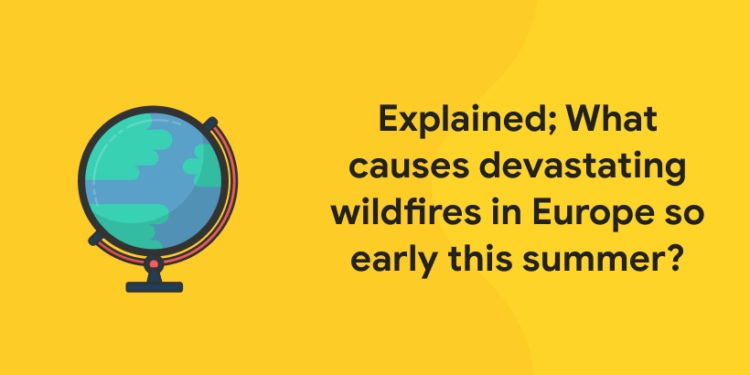Table of Contents
Wildfires out broke across southern part of Europe in the last month. Whether sparked naturally by lightning, or by arsonists, or have it been flamed by drought and extreme heat is not yet been answered clearly. Scientists have no doubt that climate change is the main factor of yet another extreme fire season. They also understand that climate adaptation in fire-prone countries is incompetent to deal with wildfires that are set to worsen.
We look at why Mediterranean and Balkan countries are so prone to wildfires and explore the consequences of a warming world in this article followed by a History of how the heat-waves have affected Europe since 1500. Finally we are going to explore if these historic fires in Europe are caused by climatic changes or not. So continue reading this blog to understand What caused devastating wildfires in Europe so early in summer.
Attempt free GK Mock Test! Download Entri App!
Why there is fire in the Mediterranean?
Summer wildfires are a natural and often an integral part of the life of Mediterranean forests. In the decade prior to 2016, around 48 thousand forest fires burned 457 thousand hectares annually across the 5 southern European nations namely Spain, France, Portugal, Italy and Greece where wildfires are most prevalent. According to the scientists, fire can also cause renewal and bring biodiversity in these regions.
Indeed, communities have learned to adapt better with the average annual fires in hot and arid regions across southern Europe, with more refined fire prevention strategies resulting in an overall decline in the no. and size of fires that have broke out since 1980.
But too often in recent years, they have escalated way beyond their normal size and intensity.
Destructive 2017 and 2018 wildfires claimed 100s of lives across an area stretching from Turkey to Spain, while countries in central and northern Europe, including Sweden, were also destroyed. Such unexpected fire events are unavoidably linked to extreme droughts and heat waves.
What is triggering these fires?
The month of July was recorded as the 2nd hottest ever in Europe (and the 3rd hottest globally). The southern part of the continent has been the focus of this extreme heat, with temperatures in Greece this week expected to peak at 117 Fahrenheit degrees (47 degrees Celsius ).
Greece and Turkey are in the midst of a heat wave that could worsen in next 30 years bringing back the memories of the nightmarish 1987 fire season that claimed more than 1,500 lives in Greece alone. In Turkey, almost 200 separate wildfires have raged across the country in just over a week, forcing some coastal dwellers and tourists to run into the Aegean for safety.
Although arson and natural causes such as lightning are equally to blame for triggering the fires, extreme heat has magnified their intensity and is the real culprit for the destruction brought across fire-hit regions. This is why at least 55% more area has burned across Europe by August 5 than the average over the previous 12 years.
This fact is compounded by obsolete forest management, and sometimes even the over-protection of natural forests.
A fire on August 1 blazed through the Pineta Dannunziana, an urban pine forest in the Italian city of Pescara, forcefully evacuating 800 people. As the area is a protected nature reserve, it is not subject to forest management such as being subjected to controlled burns or regular clearing of undergrowth. The mayor of Pescara Carlo Masci said that the undergrowth burned very quickly.
Meanwhile, existing fire suppression policies do not account for the impact of global warming on the flammability of areas where wildlands (sometimes grown up on abandoned farming land) and flourishing urban centers more commonly interface. This was proven by the flaming outer suburbs of Athens.
In most Mediterranean regions, the present wildfire management policies are generally too centralized on suppression and are no longer adapted to the current global change as written by the authors of a 2021’s “Understanding Changes to Fires in Southern Europe.”
Attempt free GK Mock Test! Download Entri App!
What has climate got to do with the fire?
While the burned area of the Mediterranean region has diminished slightly over the past 40 years, it is mainly due to more effective fire control efforts, according to the EEA (European Environment Agency).
Global heating amplifies the frequency and severity of fire as witnessed during the unexpected wildfires across Australia and California in recent times. And unavoidably, climate change has increased the risk of forest fire across the whole of Europe, including central and northern regions that are usually not fire-prone.
The present-day record droughts and heat waves across the Mediterranean region echo the events of 2018 when many countries suffered huge fires than ever before as per the EEA.
In Greece, more than 100 people died in the Attica fires of 2018. The 2nd deadliest fire event this century after the 2009 was the Black Saturday fires of Australia. An expansion of fire-prone areas and lengthier fire seasons are projected in most European regions as per the EEA.
Carbon emissions are not reducing quick enough to limit this heating, despite climate agreements like the European Green Deal and Paris Climate Accord. Since 1990, global carbon emissions has increased by 60 per cent. These emissions will rise again in 2021 following the pandemic-related slowdown in the year prior to it.
What are the repercussions of global climate change?
World-wide, wildfires are responsible for considerable greenhouse gas emissions, and for 5 % to 8 % of the 3.3 million annual premature deaths come from poor air quality, as per the climate group Carbon Brief. But carbon emissions from wildfires have been reducing in recent decades. This again is due to improvement in fire prevention.
The problem still existing is fire severity or intensity, which has a more far-reaching effect on carbon segregation since forests burn so badly that they do not grow again. In 2017, Carbon dioxide emissions from extreme wildfires across southwestern Europe like the Iberian Peninsula, southern France and Italy were the largest since 2003, reaching approximately 37 teragrams of Carbon dioxide.
To put this in context, the exceedingly wide-ranging wildfires over the Iberian Peninsula and the Mediterranean coast in 2003 resulted in the same level of anthropogenic emissions as all of western Europe for that year. And if the wildfire intensity kills off significant forest cover in 2021, the resulting loss of carbon sinks could be even more destructive for the climate.
Attempt free GK Mock Test! Download Entri App!
History: How Severe Heatwaves have Affected Europe?
1: Who was the first woman President of India?
The continent has tolerated 5 of its hottest summers since 1500, with temperatures touching 47 degrees Celsius in some regions, leaving loss of many lives.
Hot temperatures in Spain and France resulted in the increasing frequency of heatwaves in Europe.
In just over 2 decades, Europe has experienced its 5 hottest summers since 1500.
2021: Hottest ever
2021 was Europe’s hottest summer on record, as per the European climate change monitoring service Copernicus.
In 2021, Between late July and early August, Greece tolerates what PM Kyriakos Mitsotakis calls the country’s worst heatwave in over 30 years, with temperatures hitting 45 degrees Celsius (113 Fahrenheit) in some areas.
In Spain, temperatures hits 47 degree Celsius in parts of the south, as per the national weather agency AEMET.
The heat and drought led to large wildfires along the Mediterranean, beginning from Turkey and Greece to Italy and Spain.
2019: Northern Europe Suffers
The summer of 2019 brings 2 heatwaves, in late June and mid of July, leading to the death of around 2,500 people, as per the Centre for Research on the Epidemiology of Disasters of Belgium’s Louvain University.
In France, temperatures hit a record 46 degree Celsius on June 28 in the southern town of Verargues. 1000s of schools were closed.
On July 24 and 25, northern Europe records high heat. Temperatures of 42.6 degree Celsius are recorded at Lingen in northwestern Germany and 41.8 degree Celsius in Begijnendijk in northern Belgium and 38.7 degree Celsius in the eastern English city of Cambridge.
2018: Drought hits Danube
The 2nd half of July and yearl August 2018 sees very high temperatures across much of Europe leading the rivers running dry due to drought.
The Danube falls to its lowest level in 100 years in some regions, notably exposing World War II tanks in Serbia that were submerged since the conflict.
Attempt free GK Mock Test! Download Entri App!
Portugal and Spain face largely destructive forest fires.
2017: Months of Humidness
Large part of Europe, especially the south, experiences high temperature from late June to well into August.
Spain set a record of 47.3 degree Celsius on July 13 in the southern town of Montoro.
Persistent drought triggers forest fires in Portugal.
2015: Heatwaves after Heatwaves
It’s back to back heatwave throughout the summer of 2015 which led an estimated death of 1,700 people in France.
In Britain, roads melt causing delay in trains in the hottest July on record, with temperatures touching 36.7 degree Celsius at Heathrow airport.
2007: Greek forests set on fire
Central and southern Europe are scorched by drought throughout June and July, leading to a spate of forest fires in Italy, North Macedonia and Serbia.
500 People die as a Result of the Heat In Hungary
In Greece, the worst fires hit in half a century some believed to be due to arson and the rest as a result of the product of heat and drought consuming 4% of the country’s forests.
2003: Death of 70,000
Britain, France, Italy, Spain and Portugal all experience exceeding heat in the first half of August, with Portugal recording a temperature of 47.3C at Amareleja in the south.
An EU study of 16 nations puts the number of excess deaths across the bloc during the heatwave as high as 70 thousand. France and Italy each recording fatalities between 15 thousand and 20 thousand, according to various reports since.
In France, most of the victims were elderly people left to stand for themselves in an episode that traumatizes the country and causing the implementation of new systems to protect vulnerable people during heatwaves.
Grab study materials to strengthen your GK !!! Register Now !!!
Europe’s Historic Fires Caused By Climate Change?
The heat waves that hit Europe dried out its foliage. That made it much more likely to catch fire.
In Greece, the fires came quick and hard, sweeping through towns so fast that residents were trapped in clouds of smoke. Some people ran towards the ocean, immersing into the water to save themselves from the flames onshore. Others tried to take shelter in buildings and cars. But the fires, which raged through several towns on the outskirts of Athens, claimed atleast 91 lives, making it the most fatal wildfire in Europe since 1900.
In Sweden, more than 80 fires across across 100 square miles thick and normally damp northern forests. Finland and Latvia fought their own blazes.
Europe sets on fire every summer, especially around the Mediterranean. On average, about 1500 sq miles of the E.U. burn each year. But last year fires burned nearly3 times that much, causing 66 people to die in Portugal and Spain and making the firefighting efforts and budgets thin across Europe. In 2018, we are observed an expansion of the areas that are at risk, with fires occurring in countries where wildfires were not so common earlier as said by Jesús San-Miguel, who works a researcher at the European Commission’s Joint Research Centre.
These fires across Europe have something in common: they were more likely to happen, and to burn more destructively, as a result of human-caused climate change. While scientists can not assign any single fire solely to climate change, they can say that warming conditions on the globe and the ways that warming affects lead to more extreme weather, faster-growing fire, more inflammable plants, and more lightning storms—set the stage for more fires and much fatal ones in the future.
Attempt free GK Mock Test! Download Entri App!
How Earth has Made Space for Fire
Fire is both deeply simple as well as incredibly complex, with origins 100s of millions of years ago. A fire requires only 3 things: something to burn, oxygen to fuel it and a spark to set it all off.
In the first few billion years of Earth’s history, there was no fire. Lightning or molten volcanic particles (i.e. sparks) spit out into the air. But this early Earth atmosphere, high in methane and ammonia (and later, CO2) and devoid of oxygen, suppressed any photo-flames. And until a few 100 million years ago, there was nothing around to burn.
But once early plants and other photosynthezisers developed, they transformed the atmosphere, turning CO2 into drafts of oxygen. As a result, by about five hundred million years ago, the 2nd ingredient for fire was prepared. The 3rd ingredient came about thirty million years later when plants made it out of the ocean and began entering the surface of the land. Not long after that Earth experienced its first fires.
Fires have swept across the globe ever since. Despite the destruction caused by the fire, the planet’s ecosystems have evolved to bear it, or in some cases, they make use of fire to renew nutrients.
But the frequency, intensity, and extent of those fires have changed dramatically in recent years. Those changes can be closely tied to climate shifts in the past. When the Earth warms up causing the dry parts of the planet to dry out further then the fires happen more frequently and burn larger.
Graciela Gil-Romera, a paleoecologist at Aberystwyth University in Wales who studies the history of fire Said that, when you see fire frequencies raise in the past, there’s always evidence telling you there’s drier climate which can be always related to enhanced fire activity.
Spark It Up
Over the past four hundred million years, oxygen concentrations have stayed high enough to fuel fires. So the other ingredients like the amount of burnable material and the no of ways to start a flame are the main controls on modern fire.
And the sparks seem to be escalating. Not only are humans causing more fires, both purposely and unintentionally, but lightning strikes are expected to grow as the climate warms. Warmer and more turbulent air causes thunderstorms, which in turn leads to more lightning. And a recent study found that lightning induced fires were becoming more common across the northern parts of the American continent, increasing on average by 2 to 5 % each year since 1975.
Attempt free GK Mock Test! Download Entri App!
The Big Dry
But the biggest effect on how, where, and how intensely fires burn is the fuel load of combustible material. This has led an ecologist named Juli Pausas who focuses on fire at the Universitat de Valencia in Spain, to add a 4th ingredient to the recipe of fire which is “a dry season”.
“The drought is key for foretelling whether the fires will happen,” says a climate scientist named Marco Turco, at the University of Barcelona who is working to making a tool to predict where and when fires may break out in upcoming weeks. According to him, climate is the most important ingredient, as it influences the type, flammability,and availability of burnable material.
The worst fire years are likely to appear amid seasonal extremes, when a wet season that fuels high-spirited plant growth is followed by an extremely dry season that dries the water out of the plants and the soil.
These conditions are exactly what caused the fires in Europe this year. A wet winter nurtured plants across the continent, and then the heat set in. A historic heat wave which scientists say was about twice as likely to occur because of man caused climate change settled in over Europe.
Bill DeGroot, Canadian Forest Service scientist, explains that the fire “season” has prolonged over the past few decades in many parts of the globe, hugely because warmer temperatures dry out plants more thoroughly and sooner in the year. In the western U.S., the length of time between the first and last fires of the year extended by nearly 80 days since 1980. In Canada, the season is about a month longer.
A fire plan is something that’s varying and shifting all the time, is said by DeGroot. “But this variation with climate change is going to make a very significant shift in a relatively short period of time. The forest is going to look different in the coming years than what it looks now.”
Climate change speed up this process, as dry places gets drier. When the European Joint Research Centre analyzed models of future and present likelihood of fire across Europe, it found that the parts of the continent that are already dry, like Spain, Greece, Turkey, will dry out and be more susceptible to fire. Already, an average of over thirty five hundred square miles an area, more than 3 times the size of Rhode Island burn each year across Europe. By the end of the century, that number may double.
Mean while in the western U.S., climate change has warmed and dried out the plants that blanket mountains, valleys, and plains. That extra dryness made about twice as much area of the western U.S. says Park Williams, a scientist who studies the relationship between climate change and fire at Columbia University. “Fire is changing right before our eyes,” he says.
Grab study materials to strengthen your GK !!! Register Now !!!
The Sinuous Jet Stream
There’s one more way by which climate change is influencing the number and frequency of fires, and it has to do with the jet stream. Jet steam is an atmospheric highway high up in the sky that takes weather from west to east.
The shape of the jet stream, and how fast weather travels along it, depends on the temperature difference between the Arctic and the equator. When the temperature difference is tiny, weather patterns move much slowly. But climate change is causing the Arctic to heat up fast, making that temperature difference lesser. As a result, weather conditions in the northern hemisphere stay in place for longer. When it’s wet, it stays wet, accelerating plant growth. And when it’s hot, it stays hot, drying up all moisture out of those same plants.
The heat wave that settled in over the continent this summer is a good example of these dynamics in play, says the University of Arizona’s Valerie Trouet.
The jet stream moves north and south all the time—but its movements have lately become more extreme. Trouet and her colleagues had a look at three hundred year long record of the jet stream’s position over Europe, and found that in the last 3 decades, since the planet started warming as a result of humans, the jet stream was more probable to sit near one of its extremes. Either it’s very far south, causing icy arctic air sweep over the continent. Or, like now, it’s very far north, causing hot southern air come far up into Northern part of the continent. And with larger number of heatwaves and droughts, come more fires.
Conclusion
Climate change is said to have made heat waves five to ten times worse than they were about a century ago. Global warming, a human-made phenomenon, causing extreme weather events such as hotter temperatures, famines, rain, droughts and floods, which disturbs natural weather cycles. Europe’s earliest heatwave this year caused temperature to raise up to 40 degrees Celsius, the temperatures that are expected only in the months of July or August.
May 2022 marked the highest level of CO2 recorded in the Earth’s atmosphere, being about 420 parts per million, levels that have not been seen in four million years. CO2 traps heat, favouring conditions for heatwaves, droughts, and fires.
The wildfires in Spain, Germany and Greece have all been associated with hotter temperatures and low humidity caused by climate change.
Grab study materials to strengthen your GK !!! Register Now !!!
I hope this article was helpful. The key point to clear an exam lies in methodical and planned preparation. If you are a candidate who wants to pursue your dream career and looking for a good start, our Entri app has got it covered for you. Our team will help you with content and insights related to the topics of your concern. Subscribe to our app today and enrol yourself into various programmes our app offers. Tune in to the app to stay updated regarding various aspects of the subject you are interested in. Feel free to post any queries and doubts in the comment section. We will try our best to reach out. Push away all those self-doubts and negative thoughts. Try to have a clear vision. Ask yourself why you want this. Focus on the good and work hard. There is a saying that goes like this, Get up and set your shoulders to the wheel-how long is life for you? as you have come to this world leave some mark behind or where is the difference between your trees and stones they too come into existence decay and die. Each day is a precious gift bestowed upon us so make it count. Work on yourself. Stop procrastinating. Today is the day, hope for the best. Good luck.














